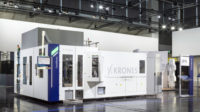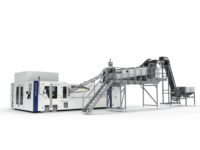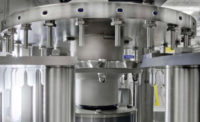Plastic bottle manufacturing addresses dedicated, flexible lines
Sustainable practices impact bottle weights, machinery’s process window

In its July 2015 report titled “Beverage Containers,” The Freedonia Group, Cleveland, forecasted that plastic beverage container demands will account for 148.8 billion units by 2019 in comparison to the 124.9 billion units in 2014, which equates to a 3.6 percent annual growth rate from 2014 to 2019. With the demands for plastic beverage containers proliferating, plastic bottle manufacturers are challenged to meet the diverse needs of beverage manufacturers.
Arne Wiese, product manager of bottles and shapes for KHS Corpoplast GmbH, Hamburg, Germany, says that two opposite trends are impacting the plastic bottle manufacturing market right now: dedicated versus flexible lines.
“We are seeing some dedicated lines, which basically do one product or one product line only, and we are seeing flexible lines,” he says. “Both mean something totally different for the manufacturing equipment. On the dedicated lines, fast output is the main focus; in other words, bigger and bigger machinery and faster machinery, and obviously optimized design to have the smallest cost possible to manufacture the bottles. … The other one is more flexible lines and there, big lines make no sense.”
Wiese details that these operations require smaller machines that are combined with blow molder filler blocks that support fast changeover. Beverage-makers’ need for fast changeover can be tied to the SKU proliferation impacting the beverage market. To help aid the challenges this has placed on plastic bottle machinery, KHS has instituted a program that allows customers to purchase dependent parts and receive delivery within eight weeks.
“Because obviously today you don’t know what bottles you will have in two or three years, [so] the product-dependent parts can be delivered later on,”
he says.
The impact of sustainability
Another macro trend impacting the plastic bottle manufacturing market is sustainability. Whether its energy output from the machinery or material lightweighting, equipment manufacturers are helping brand owners employ more sustainable practices.
“Forecasts for 2030 suggest that demands for energy will have increased by 50 percent, food by 50 percent and water by 30 percent, alongside the additional pressures brought about by an increasingly urban population,” says Nicholas Bloch, executive vice president of group communications at Sidel, Hünenberg, Switzerland. “This means that finding ways to optimize the planet’s resources in meeting those demands will only intensify and with it the need to ensure that the packaging we employ can contribute to that sustainability agenda. PET has a vital role to play. The responsible use of virgin PET across the supply chain can bring immediate and significant sustainability benefits.
“Extending that beyond the virgin resin, in its recycled form, PET can be reused time and time again, reducing consumption of what is a finite resource,” he continues. “Already the most widely recycled plastic in the world, through initiatives to further improve collection rates and the methods of recycling, PET can further strengthen its position as the sustainable package of choice. It is about taking what is currently in the waste stream and putting it in the resource stream, reaching for the ultimate objective of a closed-loop sustainable packaging supply chain.”
Among the ways Sidel has addressed this is through its RightWeight bottle, which weighs 7.95 grams. “We have used the ‘RightWeight’ name to highlight that lightweighting a bottle should not compromise the integrity of the bottle performance or the consumer experience, with a design which prevents the ‘over squeeze’ issue that can result in the spilling of contents unintentionally when using ultra-light bottles,” Bloch adds.
But as plastic bottle weights have come down, the pressure on the machinery that manufactures these bottles has increased.
“The lighter the bottles get, the narrower the process window,” KHS’ Wiese explains. “In other words, we have to make the machines more precise and find possibilities to get the blow molding process more precise.”
Among the ways the company has addressed this is by utilizing a profiler that bundles energy on a line on 2-3 millimeters, he notes. “For extreme lightweight preforms, where we always have the problem to decide where the body starts to develop mechanically, now we thermally have the possibility to always have the bottle body weight,” Wiese says. “It always is the same weight as in the thread and the spot ledge diameter and the same amount of material.”
Going forward, Wiese anticipates the plastic bottle manufacturing market will benefit from more technological advancements that will aid the carbonated and still beverage markets.
“Two years ago I would have said with carbonated we are at the limit of what shelf life existence by now needs threads and the lightweighting of threads,” he says. “Lighter and lighter threads are coming to market. ... The other one is we see an increase in recycled content. The first bottles with 100 percent recycled material are on the market today. Long term, we do see materials that are manufactured not only out of 30 percent regrown, but 100 percent regrowing materials.” BI
Looking for a reprint of this article?
From high-res PDFs to custom plaques, order your copy today!






